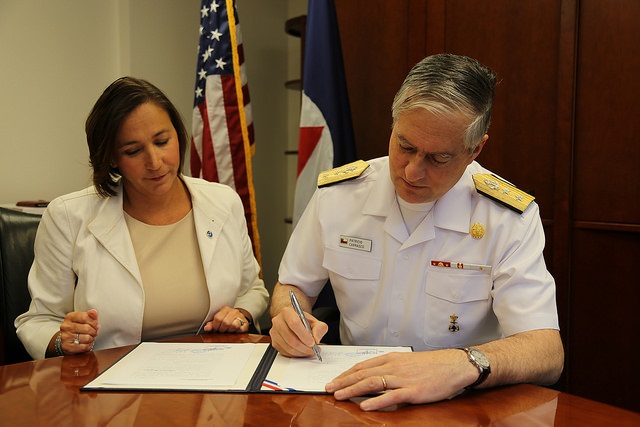
NWS DAA Laura Furgione and SHOA Director Rear Admiral Patricio Carrasco
performed a ceremonial signing of the Spanish official version of a MOU.
In 1960, the Chilean coast suffered the most powerful earthquake ever recorded and since 1996, Chile has experienced 10 tsunamis resulting from earthquakes of magnitude 6.8 or larger, including the magnitude 8.8 Maule event in 2010. Chile's tsunami-vulnerable coastline extends over 2,600 miles.
Senior leaders recognized that collaboration between U.S. and Chilean officials could improve tsunami warning capabilities in both countries and the whole Pacific Basin. Consequently, leaders from NWS and the Chilean Navy’s Hydrographic and Oceanographic Service (SHOA) embarked on a joint project to advance the detection of tsunamis, testing two new 4th generation DART tsunami monitoring systems in a very seismically active trench just off the Chilean coast. Technical experts from the Office of Oceanic and Atmospheric (OAR) Pacific Marine Environmental Lab (PMEL) deployed the DART buoy systems from a Chilean research vessel, and Chile is working with PMEL and the National Data Buoy Center to sustain these systems that provide vital information for the Pacific basin.
Chilean leaders came to the United States in late July to further the existing partnership with key U.S. tsunami warning personnel. Director of SHOA Rear Admiral Patricio Carrasco and SHOA's Oceanography Department Chief Lieutenant Commander Carlos Zuniga arrived in Washington, D.C. on July 20 and for the visit to NOAA, were joined by the Naval Attaché from Chile, Captain Juan Lerdon. They met with NWS Deputy Assistant Administrator (DAA) Laura Furgione, OAR Assistant Administrator (AA) Craig McLean, and Office of Coastal Survey Director Rear Admiral (select) Shepard Smith.
The Chilean team expressed an interest in several technological areas where NOAA scientists possess expertise. SHOA needs real-time data to create original products for the Chilean coast and exclusive economic zone, and would like to share techniques and software for tsunami modeling. NOAA’s expertise in tide and current modeling could prove helpful to Chilean scientists who face challenges because of Chile’s many fjords and channels. SHOA develops nautical charts along the Chilean coast and recently began investigating ways to incorporate dynamic tides. SHOA’s current capability is to model sea surface temperature, sea level, currents and winds using a database that provides mean values from a broad, ten-day window in low resolution.
While in Washington, D.C., RADM Carrasco and LCDR Zuniga toured the U.S. Naval Observatory (USNO), and met with key USNO staff, including the USNO’s deputy superintendent, naval oceanographer, and hydrographer of the Navy.
On July 22, the Chileans visited NWS Headquarters to review the status of the tsunami-related bilateral agreement adopted in late 2015, and discuss possibilities for new areas of collaboration with NOAA. They met with the NWS leadership team and DAA Laura Furgione provided an overview of NOAA and the NWS. RADM Carrasco gave an overview of SHOA and reported on the status of the joint project with NOAA to deploy and test two fourth generation DART buoy systems. Staff from the Office of Coast Survey briefed on nautical charts and the new electronic charting system being developed.
After lunch, DAA Laura Furgione performed a ceremonial signing of the Spanish official version of a Memorandum of Understanding. They were joined by AA Craig McLean for a discussion in Spanish about the United Nations organizations, World Meteorological Organization and the Intergovernmental Oceanographic Commission that perform international coordination in oceanography and marine meteorology. At the end of the day, the Ocean Prediction Center hosted the Chilean guests.
After two days on the east coast, RADM Carrasco and LCDR Zuniga flew to Alaska to visit the National Tsunami Warning Center (NTWC) on July 25-26 where they were hosted by the Center’s Director Paul Whitmore.
At the Center, the Chilean guests and NTWC staff shared their standard operating procedures for responding to tsunamis that are generated by both near and distant earthquakes. They discussed backup plans and procedures and shared software and hardware solutions to improve tsunami warning capabilities. They collaborated on lessons learned both from a technical perspective and a procedural standpoint.
Leaders from SHOA and the NTWC plan to investigate further data transfers, including real-time GPS, seismic and sea level data to NTWC to support tsunami alerts along the U.S. and Canadian coasts as well as further efforts related to the Chilean DART array.